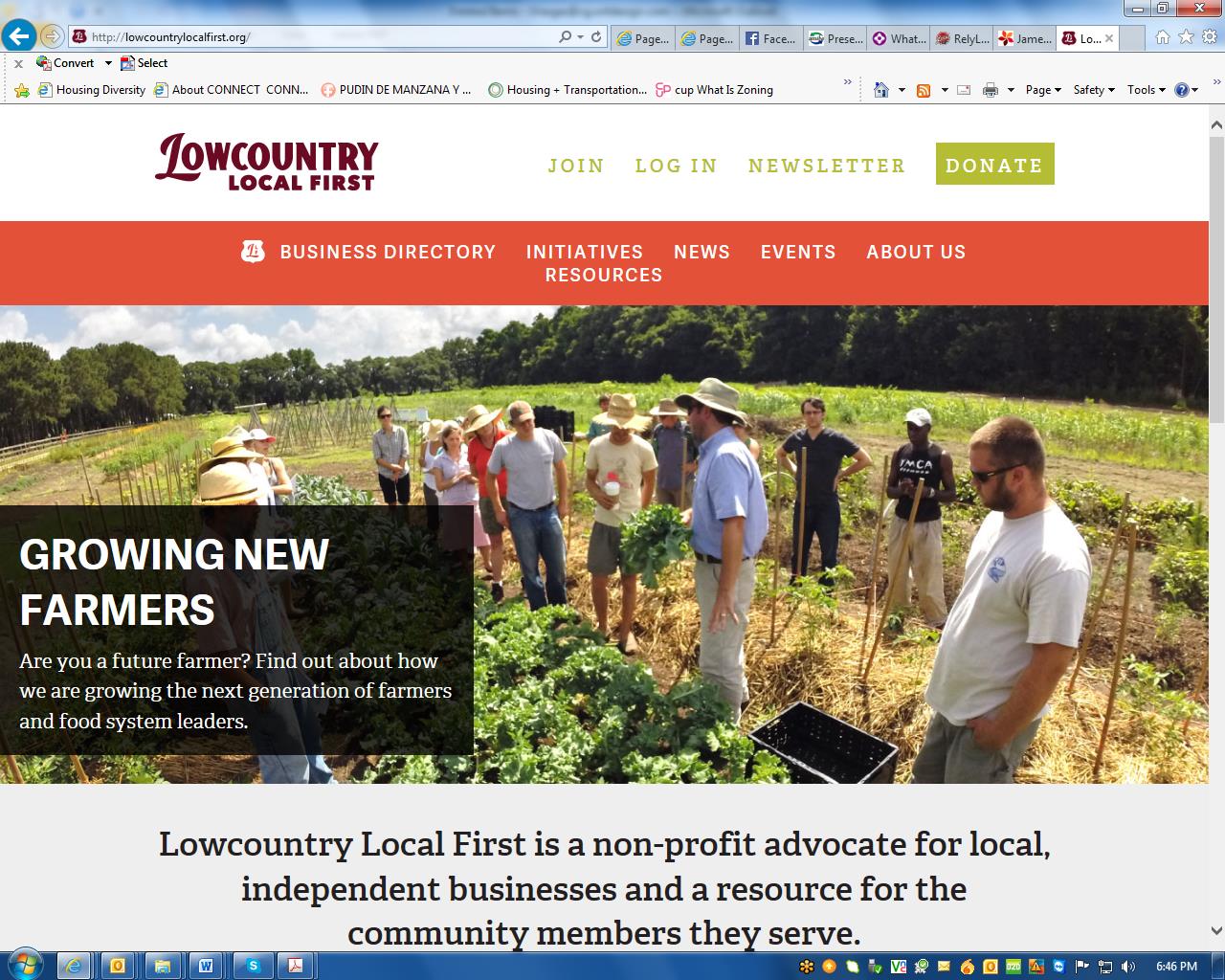"Buy local" (which may also be referred to as “shop local” or “buy independent”) campaigns and local branding educate consumers about the economic and social advantages that independent and local businesses bring to a community. The ultimate goal of these campaigns is to create a thriving local economy by maximizing the potential of local businesses and increasing their market share (business, government, and consumer purchases) relative to non-locally owned businesses.
Why is this important to your community?
Buy local campaigns or local branding add value to local farm products and provide farmers with a means to increase their marketing power. Regional branding and certification programs are often used to identify products from local farms in non-direct local markets and protect the integrity of the local market for a region’s farms. With regional branding, locally grown products are tied directly to their region of origin, providing farmers with a means to increase their marketing power and access consumers’ desire to support local farms and the local economy. “Buy local” campaigns can be a powerful tool to help promote and sustain independent businesses and neighborhood-serving business districts. When well-defined and organized, a sustained "buy local" campaign can boost local consumer spending and strengthen local culture.
Several studies have shown that money spent at a locally owned business stays in the local economy and continues to strengthen the economic base of the community. A 2003 case study in Austin, Texas, showed that local merchants generate substantially greater economic impact than chain retailers. In fact, the study found that for every $100 in consumer spending at a national bookstore in Austin, the local economic impact was only $13. The same amount spent at locally-based bookstores yielded $45, or more than three times the local economic impact.
There are other benefits to buying local as well. Small, locally-based businesses make vital contributions to communities and neighborhoods; they account for the largest share of net new jobs generated each year, and provide some of the most stable employment opportunities in a community. Small local businesses tend to have less negative impact on the environment, because often they are located in central business districts or in other existing retail areas, require comparatively little infrastructure investment and can make more efficient use of public services. Perhaps just as important, today’s entrepreneurs and creative workers are attracted to the kinds of places that value and preserve their distinctive character and local culture – the kinds of places that nurture an economy of vibrant, unique businesses. “Buying local” from local farms also preserves local farm economy, keeps farmland in use, and provides the freshest, healthiest food to local consumers, as well.
Skip directly to
How Does It Work?
Resources
Using the Tool
Partners
Where Has It Worked?
Where is it appropriate to use?
- Businesses
What priorities does it address?
What other tools are related?
- Business and Education Training for Farmers
- Community Gardens
- Farm to Table
- Local Food Councils
How does it work?
A “Buy Local” campaign means increasing demand for locally-owned, made and grown businesses, goods and services. But influencing local preferences to support local entrepreneurship is not an easy task – it requires motivation, determination, collaboration and political will, as well as an acknowledgement that a purchase can mean the possibility of a relationship and real care in our day-to-day community exchanges. And it means promoting a new paradigm: one where we support local, cooperative and community-owned businesses and each other.
“Buy Local” campaigns drive more investment toward local economies by spotlighting local innovation and improving the financial resources to locally-owned businesses and to the networks that support their success. According to the Institute for Local Self-Reliance (ILSR), which tracks some 150 buy-local campaigns nationwide, independent businesses saw revenues rise by 7.2 percent in 2011 in communities with active buy-local movements, compared to only 2.6 for independent businesses in areas without a buy-local campaign. “Buy Local” is most effective as a sustained movement involving many collaborators, rather than as a one-time or recurring event. An independent business alliance or coalition is the best vehicle for developing and moving a “Buy Local” campaign forward. These organizations typically include hundreds of business owners and citizens working together.
Ready to get started?
Using the Tool
To start a “Buy Local” campaign, the American Independent Business Alliance (AMIBA) (a nonprofit organization that helps communities launch independent business alliances and buy-local campaigns) urges communities to think about a movement. “By definition,” says Jeff Milchen, co-founder of AMIBA, “A movement occurs when many people and groups independently begin working toward a common goal.”- Start by determining whether a new organization, such as a business alliance, needs to be created, or find an existing group in the community that could do the job. To find nearby shop-local organizations, talk to other business owners or search for BALLE member organizations and AMIBA If a new organization is needed, assess whether there’s potential to develop a strong steering committee made up of local business and government leaders.
- Enlist support from key business leaders – this is by far the most crucial step and key to a successful campaign. Support from local elected officials and civic organizations is important, too, but “Buy Local” campaigns run by local governments do not have a strong record of success. BALLE recommends starting with a list of respected business owners in the community who have a positive attitude and a passionate belief in the value of local businesses. Meet with them one-on-one until you have a small core group of leaders (ideally fewer than 10 people) committed to the Buy-Local movement.
- Once the core team is in place, develop a plan for the Buy-Local organization. Define the geographic scope, membership criteria and dues (as little as $20 or $30 per year per business is enough to get started, according to BALLE). Choose a name, create a steering committee and, as necessary, action subcommittees, as well as a mission statement, vision and plan for the campaign’s first year. Focus on goals that are easily attainable –early wins. Reaching these goals will create momentum and build support in the community. For example, in the first year, the group may concentrate on developing just one campaign and doing it well (e.g., getting the support of 5 sponsors for a one-day buy local event).
- As soon as the organizational structure, plan and marketing materials are ready (which can take between six months and a year), hold a kickoff event to solicit members and inform the community about the Buy-Local movement. The type of event can vary from a luncheon focused on local business owners, to a press conference with the wider community. Alert local reporters and send out press releases before and after the event.
- After preparing the organizational structure, determine membership benefits and create marketing materials to promote the group. These could include a logo, slogan, brochure and website, as well as a “campaign kit” which may include a welcome letter; a window cling, decal or poster displaying the organization’s logo and slogan; suggestions for promoting the shop-local campaign; and information businesses can give customers, such as a “10 Reasons to Support Independent Businesses” flyer.
- Once the Buy-Local campaign launches, grow it by enlisting social media and word of mouth, and compile research, data and marketing tools. Membership in organizations such as AMIBA or BALLE can save time and money by providing resources such as business plan models, campaign ideas, and graphics templates, as well as personalized guidance to sustain the campaign over time.
- Report the economic benefits of any changes in buying habits to local leaders and to the media and public.
Partners
- Advocacy Groups
- Businesses / Business Associations
- Community Development Organizations
- Economic Development Organizations
- Elected Officials
Where has it worked?
Lowcountry Local First - Charleston, SC
About the Program
Founded in 2007, Lowcountry Local First is a 501(c)3 non-profit that advocates for local, independent businesses and a resource for its members and the local community. Lowcountry Local First was conceived as a grassroots movement to promote the benefits of buying from local, independent businesses and farmers and to promote the Lowcountry economy and culture. In order to fulfill this mission, the organizations efforts are organized under two primary initiatives:
- Buy Local, a sustainable entrepreneurship and business development initiative designed to foster and catalyze local, independent retailers, manufacturers, professional services providers and more.
- Eat Local, a sustainable agricultural initiative designed to grow and support local food systems by connecting local farms, producers and apprentices to local restaurants, grocers and community members. The goal of this initiative is to protect the local agricultural landscape, improving health and wellness and catalyzing investment and job creation in urban and rural environments.
Lowcountry Local First received recognition from the Charleston City Paper as “Best Local Cause” in 2009, 2010, 2011 was a bestowed the Sustainable Communities Award for the Public Sector by the Sustainability Institute.
Why it works
Through a variety of education, outreach and co-working programs Lowcountry Local First supports the diversity of the local business community, increasing reinvestment into local schools and infrastructure and creating stable, well-paying local jobs. Lowcountry Local First’s work includes local economic development, training and support for local business owners, awareness and education efforts aimed at the general public and advocacy for policies that recognize the importance of a strong, diverse local economy.
Since its inception, the Lowcountry Local First initiative has been responsible for developing a “Directory of Local Independent Businesses.” The organization has produced five successful “Buy Local” annual campaigns, launched a sustainable agriculture initiative and created awareness throughout the community about the importance of supporting the local Charleston economy and family farms.
This initiative works because it has produced concrete results, including:
- Training over 70 new farmers and eight mentor formers through the Growing New Farmers Apprentice program, offering new farmers the technical and business skills to succeed as food system leaders.
- Launching the first incubator farm, Dirt Works in South Carolina, with six new farmers working on ten acres, sharing resources and equipment while providing mentorship.
- Engaging 76 business owners to take measurable steps to lessening their environmental impact in partnership with the City of Charleston, the Sustainability Institute, and the South Carolina Green Fair and the Chamber of Commerce.
- Launching Local Works, which offers affordable co-working space for local entrepreneurs and professionals.
- Growing its business membership to over 500.
- Setting up the “GOODBusiness Series and Measure What Matters,” an educational platform that connects local businesses with experts and peers to share knowledge and build skills for better business performance. In 2014, the second GOOD Business Summit attracted more than 200 young people, most of them recent newcomers to the Charleston region, all focused on creating a positive community impact while nurturing successful businesses.
- Working with municipalities such as the City of Charleston and the Town of Mount Pleasant to adopt local preferences in their procurement policies.
- Holding an annual, month-long “Buy Local” effort to focus attention on local retailers, manufacturers and professional services providers (December), and an similar “Eat Local” effort to focus attention on local growers, fishermen and restaurants (April).
- Businesses / Business Associations
- Community Gardens
- Business and Education Training for Farmers



